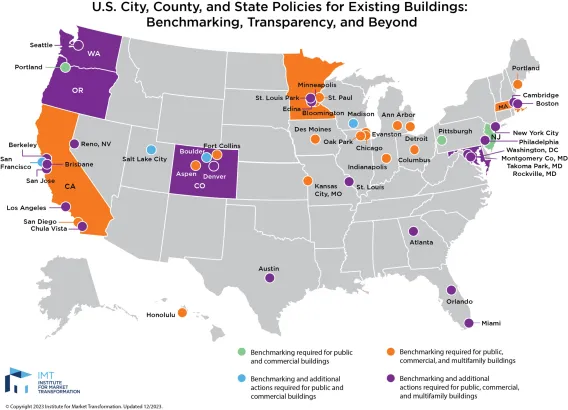Policymakers
Through ENERGY STAR, EPA has helped dozens of state and local governments design and implement voluntary policies and programs focused on commercial and multifamily buildings to save energy, reduce greenhouse gas emissions, and stimulate local economic growth. And for the dozens of governments that have chosen to pass laws requiring the use of Portfolio Manager and ENERGY STAR metrics, EPA has provided expert advice on the most appropriate use of the program’s tools and resources.
EPA’s ENERGY STAR team is available to provide technical support to state and local governments across all phases of development and implementation. Browse some of our resources below and then contact us to learn how we can help you achieve your goals.
Get an Overview of Portfolio Manager
EPA’s ENERGY STAR Portfolio Manager is a free, online utility measurement and tracking tool. It provides a variety of key performance metrics on indicators like energy use, water use, and greenhouse gas emissions. Hundreds of thousands of buildings use it to keep tabs on their performance. It’s also used by dozens of state and local governments as the IT backbone of their voluntary programs and their benchmarking and disclosure and building performance standards. Learn more about Portfolio Manager.
Key Advantages to Using Portfolio Manager
- No cost to you or building owners/managers in your jurisdiction.
- Supported by EPA’s robust training and help desk infrastructure.
- Already in use across the nation as the industry standard energy benchmarking tool, which helps minimize your risk and make compliance easier for many buildings.
Getting Started with ENERGY STAR
We’ve helped dozens of policymakers untangle the complicated task of designing and implementing their policies.
The Benchmarking & Building Performance Standard Policy Toolkit
Building Performance Standards (BPS) are policies that require commercial and multifamily buildings to meet certain performance levels, typically for energy use or greenhouse gas emissions.

Review the Benchmarking & Building Performance Standard Policy toolkit.
The Toolkit aims to inform and support state and local government decision makers who are exploring adopting policies focused on reducing energy use and greenhouse gas (GHG) emissions from existing buildings.
The toolkit includes four interconnected sections focused on different aspects of policy design and implementation. As BPS policies are new and evolving, EPA intends to update this toolkit and develop new tools and resources to support jurisdictions in the months and years ahead.
- Section 1: Benchmarking and transparency
- Section 2: Building performance standards
- Section 3: State and local government coordination
- Section 4: Access to utility data
Lessons Learned from Other Cities and States
Contact the ENERGY STAR team to learn more about which sets of data and metrics have been useful and collected by other policymakers. We can also help connect you with others with similar approaches or needs to exchange best practices and lessons learned. EPA is available to discuss plans, review draft policies, and share guidance and considerations such as ways to optimize data quality.
MAP: The Institute for Market Transformation (IMT) maintains a map showing current policies. Visit IMT's website for a larger version.

Portfolio Manager Training and Outreach Resources
We can train your staff and volunteers on how to use Portfolio Manager so that they can train others, and connect you with on-demand training resources, including our Portfolio Manager 101 webinar series. We'll also teach you how to collect data through the tool. Depending on your service area, your utility may be able to provide energy and/or water data for benchmarking. EPA is available to talk through data access solutions with states, given their authority to require the development of these solutions by the energy utilities they regulate, and with local governments that are municipal energy utilities and water utilities.
Additionally, we can share our tips for how to effectively utilize ENERGY STAR tools and resources to engage with building managers and owners and can promote training sessions and voluntary offerings to Portfolio Manager users. EPA has many voluntary tools and resources you can leverage such as running an energy-saving competition and holding ENERGY STAR Treasure Hunts. We also have raw video and script files from our demo videos, which we can share with you so that you can edit and repurpose them with compliance information specific to your requirements.
Local Insights from Portfolio Manager
On request, we can develop and share a summary of current Portfolio Manager usage in your jurisdiction to demonstrate recent activity and performance. The data will be anonymized, but will still provide granular details such as how many buildings are benchmarked by size, property type, and ENERGY STAR score.
For more information
Contact the ENERGY STAR team at statelocal@energystar.gov.
